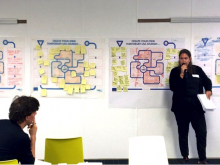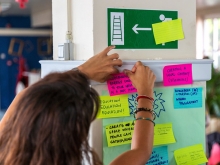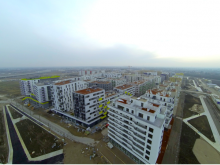Helsinki
A home for all boatsThe cityLocation : Finland
Population (2007) : 568 531 (city) 1.3 m. (metropolis)
Number of people in employment : 75,3% (met ropolitan area)
Unemployment rate : 5.2% (2008)
Income per capita: 22 621 The portRanking: international - first port in Finland
Administrative statutes : Municipal port managed by an Harbour Committee
Total traffic : 13.4 m G.T. (2007)
Container traffic (EVP) : 431 000 TEU (2007)
Total passengers : 8.5 m pax (2006)
Cruise passengers : 330 000 pax - 270 calls (2008)
Direct employment : 276
Indirect and induced employment : 470 (direct - 2007); 700 (indirect and induced - 2007)
Helsinki is the capital of Finland on the southern coast of the country, has about 577,000 inhabitants and the whole metropolitan area, Helsinki and the neighboring cities of Espoo, Vantaa and Kauniainen, about 1,300,000. The capital status means that Helsinki is Finland’s leading city for all transport, port activities, amount of tourists and is a student city with a large number of universities and institutions giving higher education. Since 2005, cruise traffic has registered an important increase with, in 2009, 360 00 passengers and 270 calls. The cruise ships moor at the West Harbor or at the South Harbor, which is also Finland’s largest passenger port. Some five million passengers pass through it annually.The West harbor also serves Tallinn and Rostock traffic. There are up to 8 departures a day to these cities. Some four million passengers pass yearly through the West Terminal.
- Short term solutions for the next five to ten years to temporarily enhance a former industrial dock yard area into uses for leisure and tourism both for the locals and the tourists. Special attention will be paid to connections from the terminal to the city, the attractiveness of the port and the surrounding area and services to the passengers and the locals
- Long term solutions to combine a new residential area of 4600 new residents and 2000 workplaces, maritime activities and cruise port in a sustainable way
SOME RELATED NETWORKS
REFILL
REFILL
In many European cities one of the positive side effects of the financial-economic crisis is the growth of innovative forms of solidarity and...
Latest activities
Article
Digital Transition in cities – how can it benefit citizens?
Digitalisation is omnipresent in today’s social and urban life and URBACT cities are seizing the opportunity.
Article
REFILL@LILLE: Policy Design Labs and URBACT exchange networks
How civil servants from Lille Metropole benefited from the experience of URBACT REFILL network to shape a roadmap to set their temporary use policy.
Article
Bringing (more) sustainability to cities: 5 golden rules
How are cities putting sustainable urban development into practice? Here are 5 golden rules from URBACT's City Lab.
Article
From non integrated to integrated urban development: an illustrated story
There are many ways to explain what integrated urban development is, or should be. One of the ways is to show examples on the opposite, i.e. on non-...
News
URBACT Infoday in Finland
The Finnish Infoday took place in Helsinki, Finland on 5 November 2014.







